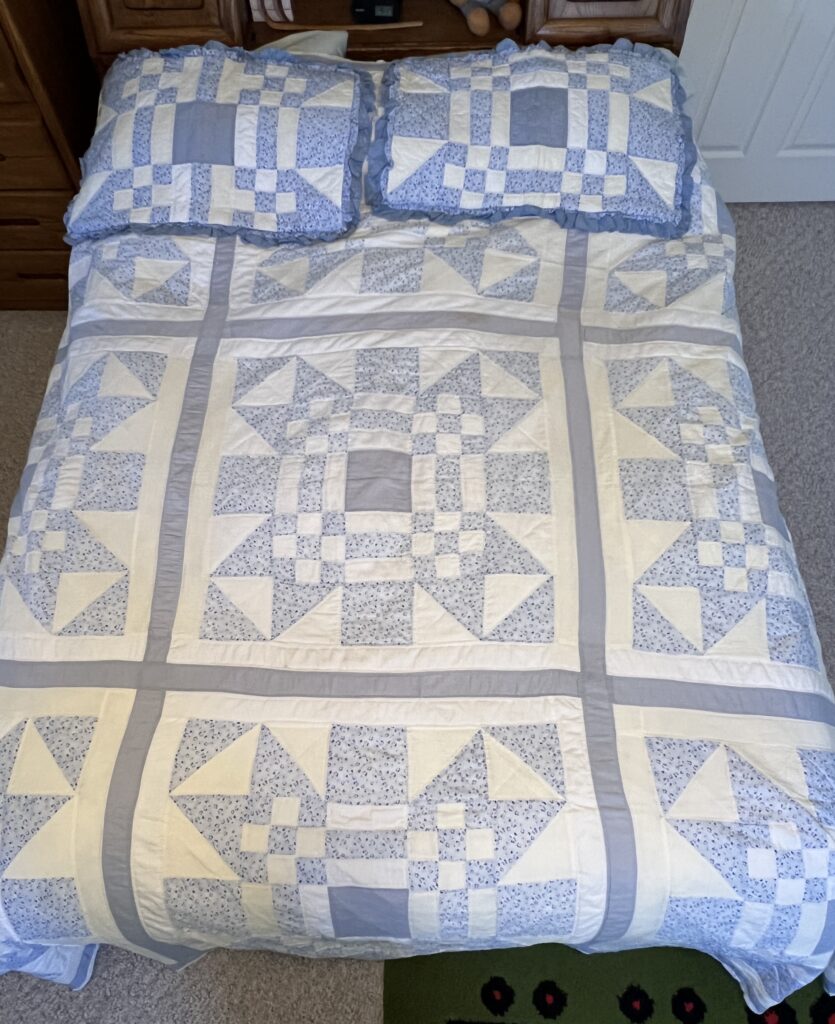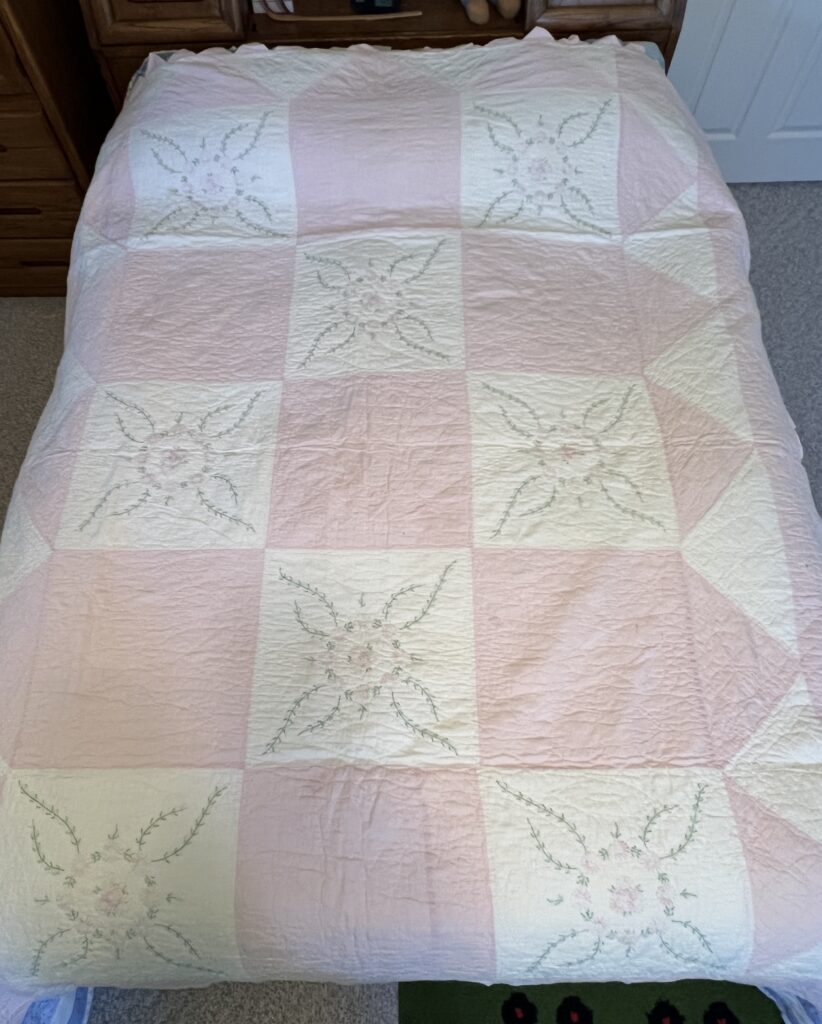In 2002, an exhibition at the Houston Museum of Fine Art entitled The Quilts of Gee’s Bend brought a new wave of international attention to the quilters of Gee’s Bend. These quiltmakers are a group of Black women and their ancestors from the Gee’s Bend area of Alabama, whose quilts are celebrated as some of the most significant artistic contributions to American art history.
The Quilts of Gee’s Bend featured quilts shown without artist images or full statements; instead, the quilts hung on stark white walls illuminated by fluorescent lighting, which has been the standard display approach for the quilts everywhere they are shown.
“It was mind-blowing for me. It took a little while for us to see what they were seeing in these quilts…I got to see all these people from different backgrounds and different ages and nationalities and races, all coming and admiring the quilts, Our eyes were beginning to open, to see that these are really art.” – Loretta Pettway
This is the same simplistic presentation that is usually used for a painting or drawing and is emblematic of the “let the works speak for themselves” approach. Museums initially chose to display Gee’s Bend quilts much the same way as one would a Paul Klee or a Henri Matisse painting. This choice was represented as an act of respect or even generosity: the recognition of quilts as equal to works associated with great cultural capital. While it may seem like a purely aesthetic choice, this minimalistic presentation was intended to ignore the long and racist history that surrounds and informs the lives of Gee’s Bend quilters and their ancestors. However, this meant that museums missed an opportunity to further explore the ways that Gee’s Bend quilts could generate unique exhibitions shaped around the particular approaches, themes, and community behind the quilts.
This project develops a framework for reimagined display of the Four Block Strip Quilt by Loretta Pettway, which is currently housed at the Baltimore Museum of Art. The project explores interactive exhibition and embodied creativity, and imagines an exhibition space that would allow visitors to learn to sew and quilt as a way of interacting with Loretta Pettway’s work.
The first step in developing a new exhibition may include the reframing of the display around the act of quilting itself. In the Gee’s Bend tradition, quilting is best understood through the act of creating a quilt. An artist in the company of her community has simultaneous support and inspiration, admiring the work of others through the embodied practice of sewing fabric. As museums work to diversify and bring in these beautiful quilts, it is important to center the original functionality and intention of the artist and object.
Guiding Principles
This project aims to center the lived experiences and words of the quilters. It also seeks to question the aspects of the current museum display practices that are built on mainstream Western conceptions of art. The overarching goal is to develop a framework for more community-focused and inclusive museum exhibitions.
Personal Introduction
This project is informed by my personal background, by my family, and my home. I come from a family of Irish quilters, ancestors who have taught one another to quilt for generations. My great-grandmother, Teresa Alice Grove Klutenkamper, traveled to the United States from Ireland when she was 16, carrying the knowledge of quilting with her. With the little money she had, she purchased a sewing machine, creating and tailoring clothing for herself and making enough to survive by sewing for others. This love and reliance of sewing carried through her whole life, and she taught both my grandmother and mother to sew and quilt, skills she had learned with her mother in Ireland. These skills have been passed down to me and have been intrinsic in my understanding of collaborative creativity and the ways that artistic intuition can be taught and shown. Attached are two quilts created collaboratively by my great-grandmother and grandmother Teresa Kunz.


Baltimore Museum of Art
This project is also built on a personal understanding of Baltimore, as someone who grew up in the city, exploring the Baltimore Museum of Art regularly. I have watched the BMA transform from a place that was shaped primarily by historical art intended to showcase a white ideal of cultural modernization and achievement into an institution that reflects and welcomes its surrounding community. In 2015, the BMA doubled the gallery space for Asian art and more than tripled the space for African art. In the following years, they deaccessioned paintings by artists including Franz Kline, Robert Rauschenberg, and Andy Warhol, raising $16.2 million to acquire more works by women and artists of color. They also opened BMA Lexington Market, which hosts a variety of collaborative art activities for the Baltimore community. I see the BMA as an ideal space to expand approaches to exhibition and display because of this commitment to increasing community accessibility and overall diversity.
“History of Gee’s Bend.” History of Gee’s Bend | Souls Grown Deep, www.soulsgrowndeep.org/history-gees-bend. Accessed 7 May 2025.
Gaye-Duparc, Aby. “The Gee’s Bend Quilt Collective: A Story of the South.” AWARE Women Artists / Femmes Artistes, 14 Sept. 2023, awarewomenartists.com/en/magazine/le-gees-bend-quilt-collective-une-histoire-du-sud-des-etats-unis/#:~:text=In%202002%2C%20the%20quilters’%20work,influence%20on%20numerous%20contemporary%20artists.
“How a Small Alabama Community Stitched Itself into the History of American Art.” It’s Nice That, www.itsnicethat.com/features/loretta-pettway-bennett-gees-bend-quilt-makers-exhibition-art-131021. Accessed 7 May 2025.
“Interview with Loretta Pettway.” Souls Grown Deep Foundation, 2025.
Morley, Annabel. “Interview with Teresa Kunz.” 2025.
Staff, BMA. “The BMA at 110: A Selection of Milestones, 1914 to 2024.” BMA Stories, 22 Jan. 2025, stories.artbma.org/the-bma-at-110-a-selection-of-milestones-1914-to-2024/.
[…] Exhibition Matters […]